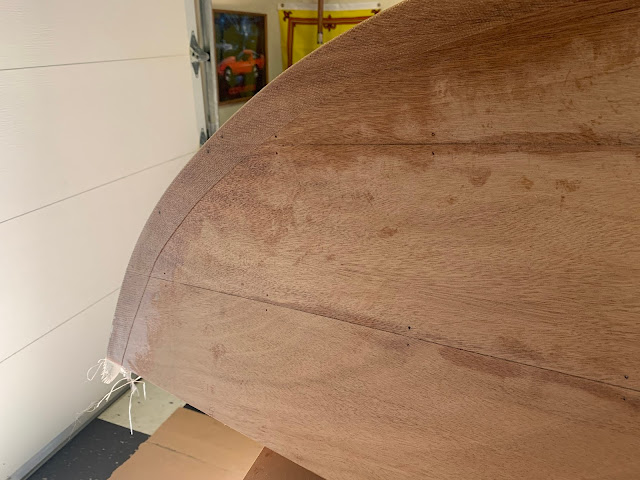The hull has now been sanded on the outside and is looking good to go. The thickened epoxy around the bow has been nicely shaped.
The CLC Expedition Wherry manual has you fiberglass the inside of the hull before the outside, and they have you add fiberglass tape to the outside keel after you fiberglass the outside. They have the tape on the outside layer.
I'm switching it all around and doing those things in reverse order. It just makes more sense to me. Here is what I'm doing:
1. I'm adding the keel tape first. The tape is intended to be an extra guard against rocks and dragging on the beach and such. The idea is that if it wears away that you can epoxy on another strip of tape in the future. I agree, but there is no reason that you must SEE the tape. Even the CLC manual has you sand the hull smooth, and so the tape would somewhat disappear anyway. However, putting the tape under the main fiberglass layer helps to hide it more. It also acts as a way to help hold the bow and panels together for the time being. You can always still add future tape if needed.
I installed the tape by first painting on epoxy about an inch and a half on each side of the keel from the bow to where the skeg will be installed.
Then I placed the tape over the epoxy. The epoxy helps to keep the tape from sliding while you wet it out. I used my gloved hands to press the tape as best I could into the epoxy.
I then wetted out the tape with additional epoxy. The tape along the curve of the bow tended to buckle a bit, but that is easily fixed. Once all wetted out, take your GLOVED hands and starting from the front, gently pull and smooth the tape aftward and downward. The wetted-out tape will conform to the shape of the bow. You'll see that you then have to continue this pulling and smoothing all the way to the end of the tape.
This pulling and smoothing also spreads the epoxy out from the tape, essentially squeegeeing the tape a bit. This is good! You do not want the tape to float over the wood. Instead you want it to tightly conform to the hull shape.
Today I will scrape and sand the tape in preparation for the entire outside to be glassed.
2. I'm fiberglassing the outside of the hull before the inside. If I were a first-time builder, fiberglassing the outside (convex) side is much easier than the tricky concave bits. Secondly, this will give the hull a huge amount of added support while the inside is glassed. There's no reason that I can see to glass the inside first. Let's get it done.
Here's how the seams look now.
More later,
Aloha!





Comments
Post a Comment